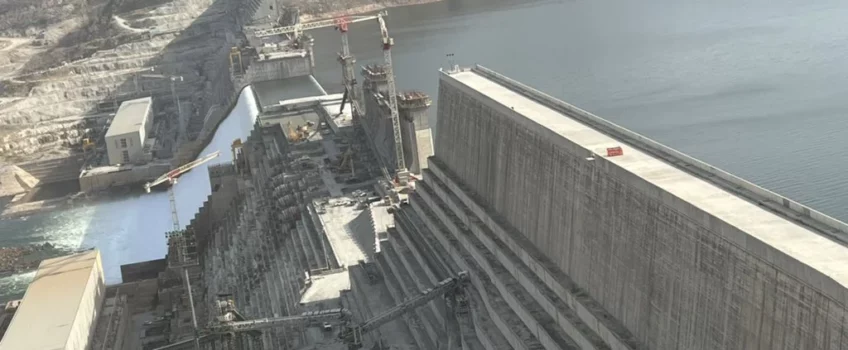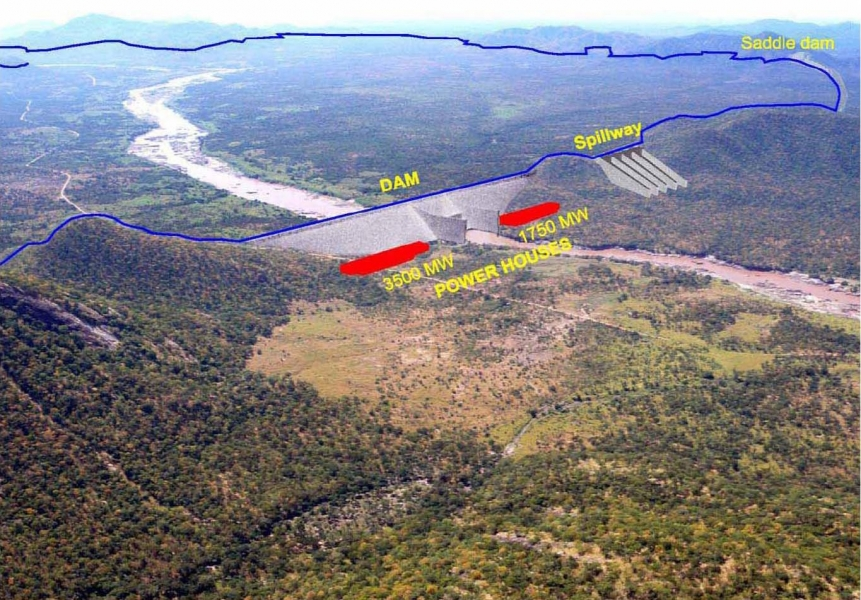
In the heart of Ethiopia, a colossal dam construction project is taking shape – The Grand Ethiopian Renaissance Dam (GERD). This mammoth structure is no ordinary dam either; it’s a mega-dam towering twice the height of the Golden Gate Bridge, and covering a reservoir expanse almost as big as London. With its ability to generate over 5,000 megawatts of electricity, the dam holds the potential to lift millions out of poverty.
The Economic Miracle of Ethiopia: How Infrastructure Shapes a Nation’s Growth
Ethiopia’s pursuit of extensive infrastructure development is a testament to the transformative power of strategic investment. A nation where half of the population lacks access to electricity, Ethiopia recognises the vital role that infrastructure plays in stimulating economic growth and alleviating poverty.
The Grand Ethiopian Renaissance Dam exemplifies the country’s commitment to harnessing its natural resources for economic development. Once operational, the dam is expected to generate more than double the nation’s current electricity output. This will have a tremendous impact on Ethiopia’s economy, particularly in rural areas where access to electricity is limited.
In addition to energy production, it will create numerous job opportunities. During the dam construction phase alone, the project has already generated thousands of jobs and once operational, it will also stimulate sectors such as manufacturing and agriculture, leading to even further job creation. Let’s take a closer look at what a typical dam construction project entails.
What Is Dam Construction?
Considering the sheer size of this project, and the fact that PRV is an engineering company, this article wouldn’t be complete without explaining the dam construction process in a bit more detail. Constructing a dam is kind of like building a LEGO set, but instead of plastic bricks, we’re working with lots of earth, concrete, and high-tech equipment. Furthermore, the engineers who work on this are like master builders, each having a special role to play.
So, who are the master builders in dam construction?
First up, we have civil engineers. They’re like the architects of the project, deciding what type of dam will work best for the location, and drawing up the plans.
Then we have engineering geologists and hydrologists, who are like the detectives of the team. They study the land and the water to make sure the dam design suits the environment. They look at how much water needs to be managed and make sure the ground where the dam will be built is sturdy and safe.
The mechanical engineers are like the gadget gurus. They design all the cool machinery parts like pipes, valves, and floodgates. These help control the water flow once the dam is up and running.
And then we have geotechnical engineers. They’re kind of like the doctors for the land under the dam, checking to make sure it’s strong enough to hold up the dam’s weight and won’t let any water sneak through.
Recommended: Tips for Mechanical Engineering Graduates
Dam Construction: Step-by-Step
Step 1: River Diversion
First, you have to divert the river, which is like temporarily moving a road so you can work on it. Depending on how much water is flowing, you might tunnel or channel the water around the construction site, or you could create a dry work area on one side of the river while the water continues to flow on the other side.
Step 2: Laying the Foundations
Next in the dam construction process is the foundation which is like the baseplate for your LEGO project. Any weak soils or rocks are replaced with stronger materials to make sure the dam won’t shift or crack. If the foundation is rock, any cracks are filled with grout (like a paste) to prevent water from sneaking through.
Step 3: Dam Construction: Building the Dam
The dam is then built piece by piece. If it’s a concrete dam, they’ll set up a concrete-making plant right on the site. This concrete gets moved to the construction site, where it’s poured into special moulds, kind of like making a sandcastle. They build the dam one small section at a time, letting each one harden before adding the next. If it’s an embankment dam, made of earth or rocks, the construction is a bit like making a layered cake. Thin layers of material are spread out and compacted, again building from the bottom up.
Step 4: Post-construction
Once dam construction is complete, it’s time for the final steps. They fill the reservoir (the big pool that forms behind the dam), test all the valves and floodgates, and keep a close eye on the dam to make sure it’s behaving as expected.
Building a dam is a huge project with lots of moving parts, kind of like the biggest, coolest LEGO set you can imagine. But instead of building a spaceship or castle, these engineers are creating a structure that can provide electricity, water for irrigation, and flood protection.
Also Read: Three Gorges Dam: Engineering Marvel or Imminent Disaster
Facilitating Trade and Connectivity Through Dam Construction

Infrastructure projects are also pivotal in enhancing trade and connectivity. With improved transportation networks and access to reliable electricity, Ethiopia could fortify its position as a significant player in regional trade. This development can attract foreign investment and foster the growth of local businesses.
However, Ethiopia’s impressive economic growth story is not without its challenges. The construction of large-scale projects such as the Grand Ethiopian Renaissance Dam often necessitates substantial financial resources and careful management to ensure sustainability and minimal environmental impact.
Moreover, geopolitical tensions, such as those surrounding the Nile water rights, underscore the intricate balance between national development and regional stability. Successfully navigating these challenges is crucial to maximise the benefits of infrastructure development while significantly reducing the potential drawbacks.
This dam construction project has earned its “epic” moniker, symbolising not just Ethiopia’s ambitious infrastructural initiatives, but also the country’s transformative economic growth over the years, often termed the “Ethiopian economic miracle”. It’s not all good news, though, as it could cause significant regional tension over the Nile’s water rights. In the next section we take a closer look at the Nile dispute but you can find out more here.
Water Politics: The Geopolitical Implications of the Nile Water Dispute
Water has always been a crucial resource, not only for sustaining life but also for socio-economic development. However, the equitable distribution of water resources, particularly of shared rivers, has been a source of contention and conflict worldwide. One of the most prominent instances of such disputes is seen in the Nile Basin, where Ethiopia, Sudan, and Egypt are entangled in an intense debate over the waters of the Nile.
The centrepiece of this dispute is the Grand Ethiopian Renaissance Dam (GERD), a mega dam constructed by Ethiopia on the Blue Nile, one of the Nile’s primary tributaries. Ethiopia sees this dam construction project as the key to its energy security and economic development. By producing over 5,000 megawatts of electricity, the GERD will address the country’s power deficit, stimulating industrial growth and reducing poverty levels. However, downstream countries, Sudan and especially Egypt, view this dam construction with deep concern.
Battle Of The Nile
Egypt, in particular, is heavily dependent on the Nile for its water needs. An estimated 85% of Egypt’s water comes from the Nile, and almost 95% of its population lives within a few kilometres of the river. Hence, any potential disruption or alteration in the river’s flow due to the GERD could have significant implications for Egypt’s water security and, by extension, its national security.
Sudan finds itself in a delicate position, balancing potential benefits from the GERD, such as regulated river flow and reduced flooding, against risks such as lowered water levels affecting agriculture.
The dispute over the Nile’s waters thus transcends national boundaries, becoming a geopolitical issue. It raises questions about international water law, sovereignty, and regional stability. The countries’ inability to reach a trilateral agreement on the dam’s filling and operation further exacerbates the situation.
The geopolitical implications of the Nile water dispute are far-reaching. They underscore the urgency of collaborative, equitable, and sustainable management of shared water resources, not only for the Nile Basin countries but also for other regions grappling with similar disputes. As Ethiopia continues on its path of economic development, the world watches eagerly, keen to learn from its experiences.
Final Thoughts
As far as dam construction projects go, the Grand Ethiopian Renaissance Dam holds the potential to transform Ethiopia’s future, powering its economy and reducing poverty but it also throws a stark light on the complex politics of shared water resources.
GERD brings into focus the fragile balance between national aspirations and regional cooperation, especially when it comes to shared natural resources like the Nile. It underscores how water, one of the most basic elements of life, can become a catalyst for both conflict and cooperation.
As we look towards the future, the unfolding saga of GERD poses critical questions for all of us. How do we equitably share resources that know no borders? How can nations pursue their aspirations without jeopardising the interests of their neighbours? Can regional cooperation pave the way for sustainable development and peace?


 Mail:
Mail: 



